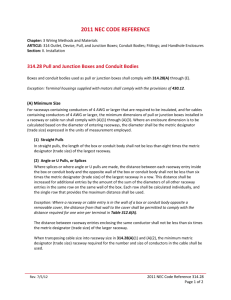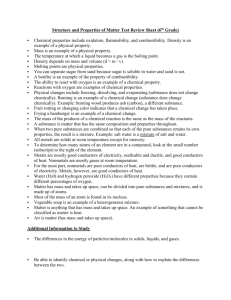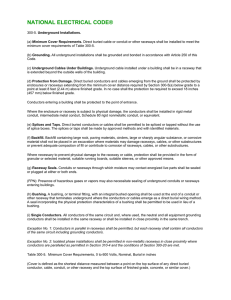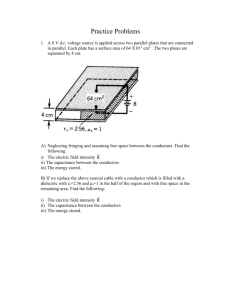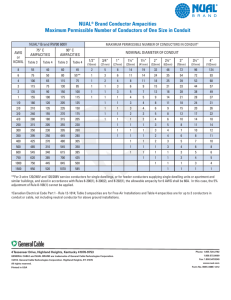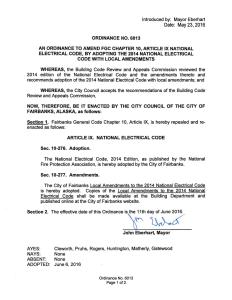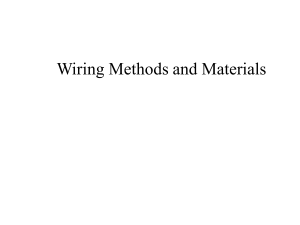Practice test 3 - Smittys Electrical Education Web Page
advertisement
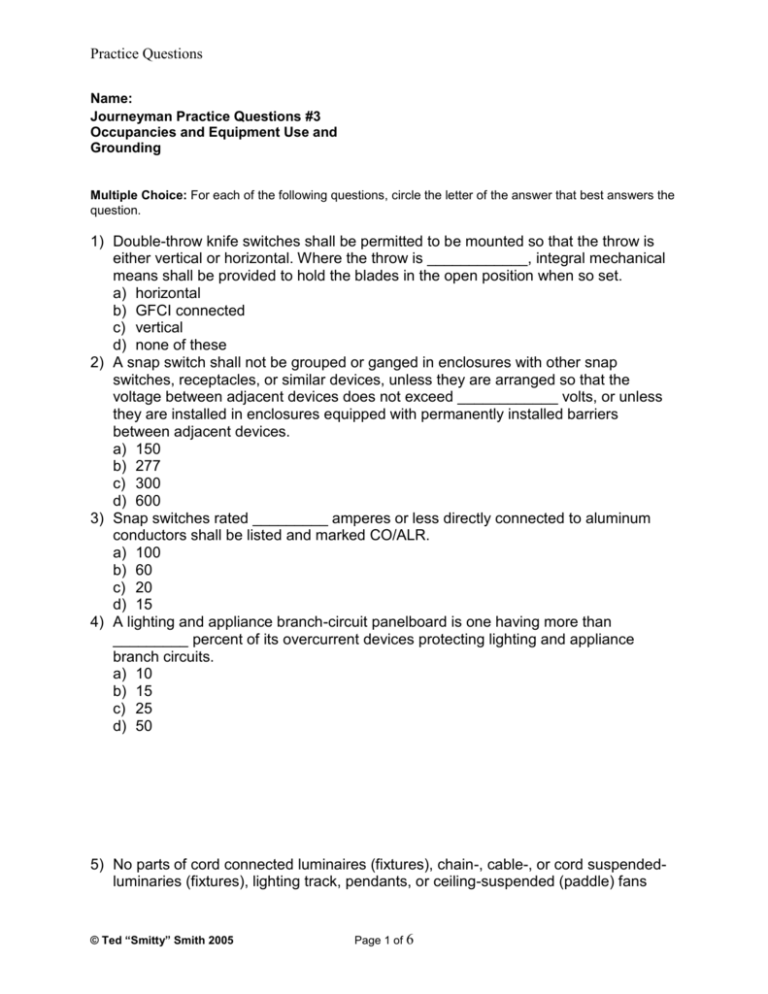
Practice Questions Name: Journeyman Practice Questions #3 Occupancies and Equipment Use and Grounding Multiple Choice: For each of the following questions, circle the letter of the answer that best answers the question. 1) Double-throw knife switches shall be permitted to be mounted so that the throw is either vertical or horizontal. Where the throw is ____________, integral mechanical means shall be provided to hold the blades in the open position when so set. a) horizontal b) GFCI connected c) vertical d) none of these 2) A snap switch shall not be grouped or ganged in enclosures with other snap switches, receptacles, or similar devices, unless they are arranged so that the voltage between adjacent devices does not exceed ____________ volts, or unless they are installed in enclosures equipped with permanently installed barriers between adjacent devices. a) 150 b) 277 c) 300 d) 600 3) Snap switches rated _________ amperes or less directly connected to aluminum conductors shall be listed and marked CO/ALR. a) 100 b) 60 c) 20 d) 15 4) A lighting and appliance branch-circuit panelboard is one having more than _________ percent of its overcurrent devices protecting lighting and appliance branch circuits. a) 10 b) 15 c) 25 d) 50 5) No parts of cord connected luminaires (fixtures), chain-, cable-, or cord suspendedluminaries (fixtures), lighting track, pendants, or ceiling-suspended (paddle) fans © Ted “Smitty” Smith 2005 Page 1 of 6 shall be located within a zone measured __________________ mm horizontally and 2.5 m (8 ft) vertically from the top of the bathtub rim or shower stall threshold. This zone is all encompassing and includes the zone directly over the tub or shower stall. a) 150 b) 300 c) 600 d) 900 6) Termination provisions of equipment for circuits rated 100 amperes or less, or marked for 14 AWG through 1 AWG conductors, shall be used only for one of the following: (1) Conductors rated 60°C (140°F) (2) Conductors with higher temperature ratings, provided the ampacity of such conductors is determined based on the 60°C (140°F) ampacity of the conductor size used 3) Conductors with higher temperature ratings if the equipment is listed and identified for use with such conductors (4) For motors marked with design letters B, C, or D, conductors having an insulation rating of __________ or higher shall be permitted to be used provided the ampacity of such conductors does not exceed the 75°C (167°F) ampacity. a) 60 C b) 75 C c) 90 C d) None of the above 7) Circuits exceeding 277 volts, nominal, to ground and not exceeding 600 volts, nominal, between conductors shall be permitted to supply the following: (1) The auxiliary equipment of electric-discharge lamps mounted in permanently installed luminaires (fixtures) where the luminaires (fixtures) are mounted in accordance with one of the following: a. Not less than a height of ___________ ft on poles or similar structures for the illumination of outdoor areas such as highways, roads, bridges, athletic fields, or parking lots b. Not less than a height of 5.5 m (18 ft) on other structures such as tunnels. a) 19 b) 22 c) 25 d) 30 8) All 120-volt, single-phase, ______________ branch circuits supplying outlets installed in dwelling unit bedrooms shall be protected by a listed arc-fault circuit interrupter, combination type, installed to provide protection of the branch circuit. a) 15 ampere b) 20 ampere c) 15 and 20 ampere d) None of the above 9) Wall Space. As pertains to dwelling unit receptacle placement requirements, a wall space shall include the following: (1) Any space ___________ mm or more in width (including space measured around corners) and unbroken along the floor line by doorways, fireplaces, and similar openings (2) The space occupied by fixed panels © Ted “Smitty” Smith Page 2 of 6 in exterior walls, excluding sliding panels (3) The space afforded by fixed room dividers such as freestanding bar-type counters or railings. a) 200 b) 400 c) 600 d) 900 10) Sealing, Class II, Divisions 1 and 2. Where a raceway provides communication between an enclosure that is required to be dust-ignitionproof and one that is not, suitable means shall be provided to prevent the entrance of dust into the dustignitionproof enclosure through the raceway. One of the following means shall be permitted: (1) A permanent and effective seal (2) A horizontal raceway not less than __________ meters, or (3) A vertical raceway not less than 1.5 m (5 ft) long and extending downward from the dust-ignitionproof enclosure. a) 2 b) 3.05 c) 4.19 d) 5.15 True or False: For each statement, circle True or False. True False True False True False Intrinsically Safe Circuit. A circuit in which any spark or thermal effect is incapable of causing ignition of a mixture of flammable or combustible material in air under prescribed test conditions. True False Intrinsically safe apparatus shall be permitted to be installed in any hazardous (classified) location for which it has been identified. True False All fixed wiring in a hangar but not installed in a Class I location as classified in 513.3 shall be installed in metal raceways or shall be Type MI, TC, or AC cable. © Ted “Smitty” Smith Pendant luminaires (fixtures) shall be suspended by threaded rigid metal conduit stems, threaded steel intermediate metal conduit stems, by chains with approved fittings, or by other approved means in Class II, Div. 1 areas. In Class III, Division 1 locations, the wiring method shall be rigid metal conduit, rigid Nonmetallic conduit, intermediate metal conduit, electrical metallic tubing, dusttight wireways, or Type AC or MI cable with listed termination fittings. Page 3 of 6 True False Underground wiring for bulk storage plants shall be installed in threaded rigid metal conduit or threaded steel intermediate metal conduit or, where buried under not less than 900 mm (3 ft) of cover, shall be permitted in rigid nonmetallic conduit or a listed cable. True False The wiring of the emergency system in a hospital shall be mechanically protected. True False Portable stage and studio lighting equipment and portable power distribution equipment shall not be permitted for temporary use outdoors, provided the equipment is supervised by qualified personnel while energized and barriered from the general public. True False Each receptacle of dc plugging boxes shall be rated True False In closed construction in a manufactured building the cables shall be permitted to be secured only at cabinets, boxes, or fittings where 10 AWG or smaller conductors are used and protection against physical damage is provided. at not less than 20 amperes in a motion picture studio or motion picture studio. Definitions: Match the definitions to the words listed in the blocks below. Critical Branch. Building Grounded, Solidly. Listed Component. Ground Anesthetizing Location. Approved Junction Box Closed Construction Labeled Stand Lamp (Work Light) Grounded, Effectively. Bonding Jumper, Equipment. Outlet Coordination (Selective) 1) A subsystem of the emergency system consisting of feeders and branch circuits supplying energy to task illumination, special power circuits, and selected receptacles serving areas and functions related to patient care, and which are connected to alternate power sources by one or more transfer switches during interruption of the normal power source.. 2) Any area of a facility that has been designated to be used for the administration of any flammable or nonflammable inhalation anesthetic agent in the course of examination or treatment, including the use of such agents for relative analgesia.. © Ted “Smitty” Smith Page 4 of 6 3) A portable stand that contains a general-purpose luminaire (lighting fixture) or lampholder with guard for the purpose of providing general illumination on the stage or in the auditorium. 4) Any subsystem, subassembly, or other system designed for use in or integral with or as part of a structure, which can include structural, electrical, mechanical, plumbing, and fire protection systems, and other systems affecting health and safety.. 5) Any building, building component, assembly, or system manufactured in such a manner that allconcealed parts of processes of manufacture cannot be inspected before installation at the building site without disassembly, damage, or destruction. 6) The connection between two or more portions of the equipment grounding conductor. 7) Localization of an overcurrent condition to restrict outages to the equipment affected, accomplished by the choice of overcurrent-protective devices or settings. 8) A conducting connection, whether intentional or accidental, between an electrical circuit or equipment and the earth or to some conducting body that serves in place of the earth. 9) Connected to ground without inserting any resistor or impedance device. 10) Intentionally connected to earth through a ground connection or connections of sufficiently low impedance and having sufficient current-carrying capacity to prevent the buildup of voltages that may result in undue hazards to connected equipment or to persons. 11) Equipment, materials, or services included in a list published by an organization that is acceptable to the authority having jurisdiction and concerned with evaluation of products or services, that maintains periodic inspection of production of listed equipment or materials or periodic evaluation of services, and whose listing states that the equipment, material, or services either meets appropriate designated standards or has been tested and found suitable for a specified purpose. 12) Equipment or materials to which has been attached a label, symbol, or other identifying mark of an organization that is acceptable to the authority having jurisdiction and concerned with product evaluation, that maintains periodic inspection of production of labeled equipment or materials, and by whose labeling the manufacturer indicates compliance with appropriate standards or performance in a specified manner. 13) A point on the wiring system at which current is taken to supply utilization equipment. © Ted “Smitty” Smith Page 5 of 6 © Ted “Smitty” Smith Page 6 of 6
